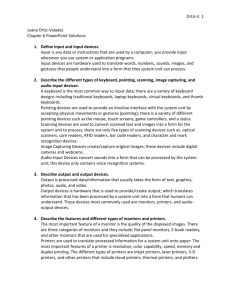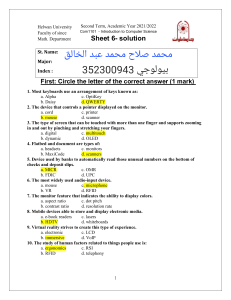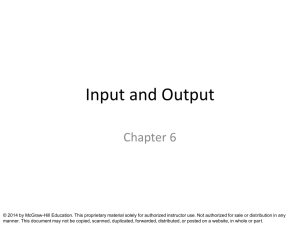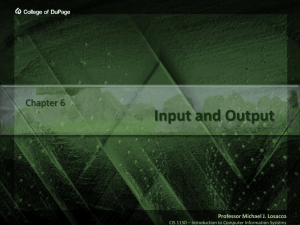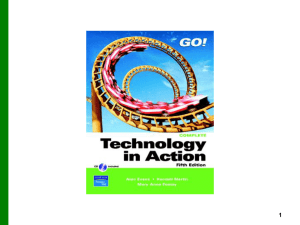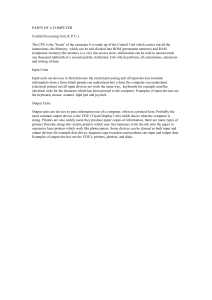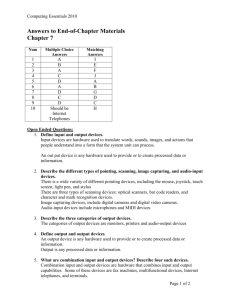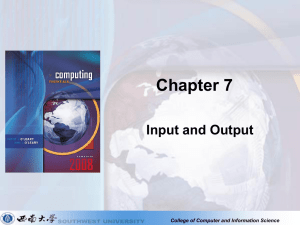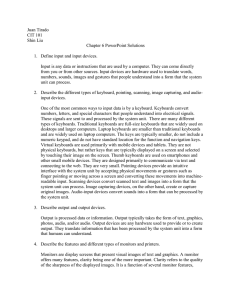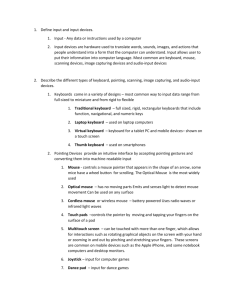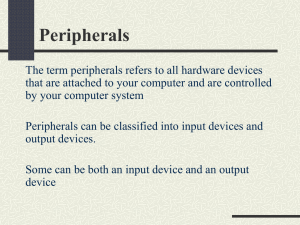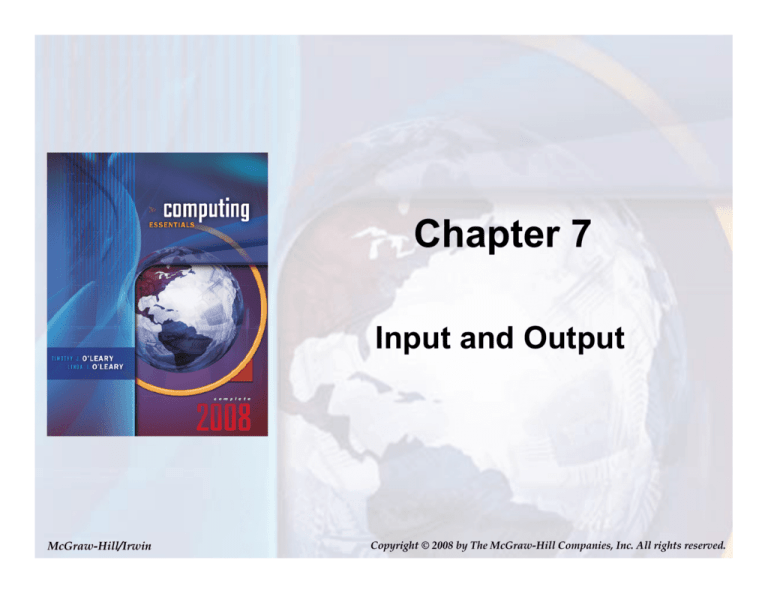
Chapter 7
Input and Output
McGraw-Hill/Irwin
Copyright © 2008 by The McGraw-Hill Companies, Inc. All rights reserved.
Competencies (Page 1 of 2)
• Define input
• Describe keyboard entry, pointing devices, and
scanning devices
• Discuss image capturing devices, including digital
cameras, digital video cameras, and audio input
devices
7-2
Page 186
Competencies
(Page 2 of 2)
• Define output
• Describe monitors, printers, and audio output
devices
• Discuss combination input and output devices,
including fax machines, multifunctional devices,
Internet telephones, and terminals
7-3
Page 186
Introduction
Do you ever wonder how information gets into
your computer and comes out in a form you
can use?
Input devices convert what we understand into
what the system unit can process.
Output devices convert what the system unit has
processed into a form that we can understand.
Input and output devices are the focus of this
chapter.
7-4
Page 187
What is Input?
• Any data or instructions used by a computer
• Input devices
– Hardware
•
•
•
•
Keyboards
Pointing devices
Scanning devices
Other devices
– Translates data into a form that the system unit
can process
7-5
Page 188
Keyboard Entry (Page 1 of 2)
• Keyboards
– Traditional keyboards
– Flexible keyboards
– Ergonomic keyboards
– Wireless keyboards
– PDA keyboards
• Features
– Typewriter keyboard with numeric keypad
– Special purpose keys
• Toggle and combination keys
7-6
Page 188
Keyboard Entry (Page 2 of 2)
Traditional Keyboard
7-7
Page 189
Pointing Devices (Page 1 of 2)
• Mice
– Mechanical
– Optical
– Cordless
or wireless
• Three similar devices to mice
– Trackball
– Touch pads
– Pointing stick
7-8
Page 190
Pointing Devices (Page 2 of 2)
• Joystick
• Touch Screen
• Light Pen
• Stylus
7-9
Page 191
Scanning Devices (Page 1 of 2)
• Optical scanners
– Flatbed scanners
– Portable scanners
• Card Readers
– Magnetic card readers
– Radio Frequency card readers
7-10
Page 192
Scanning Devices (Page 2 of 2)
• Bar code readers
– Handheld wand readers or platform scanners
– Contain photoelectric cells that read bar codes
• Character and mark recognition devices
– Magnetic ink character recognition (MICR)
– Optical-character recognition (OCR)
– Optical-mark recognition (OMR)
7-11
Page 193
Image Capturing Devices
• Digital cameras
– Images recorded digitally on a disk
– Images can be downloaded to a computer
• Digital video cameras
– Records motion digitally
– Can take still images as well
– WebCams
• Specialized digital video cameras
• Broadcast images over the Internet
7-12
Page 194
Webcams And Instant
Messaging
• Exchange messages
and files with friends
• Voice and video
capabilities
• Application sharing
7-13
Page 196
Audio-Input Devices
• Voice recognition
systems
– Use a microphone, a
sound card, and
special software
– Users can operate
computers and create
documents using
voice commands
7-14
Page 198
What is Output?
• Processed data or information
• Types of output
– Text
– Graphics/Photos
– Audio & video
• Output devices
– Monitors
– Printers
– Other Devices
7-15
Page 198
Monitors (Page 1 of 2)
• Known as screens or display screens
• Output referred to as soft copy
• Features
– Resolution/pixels
– Dot pitch
– Refresh rate
– Size
7-16
Page 198
Monitors (Page 2 of 2)
• Cathode-ray tube (CRT) monitors
• Flat-panel monitors
– Require less power to operate
– Portable and thinner than CRTs
• Other monitors
– E-books
– Data projectors
– High-definition television (HDTV)
7-17
Page 199
Printers (Page 1 of 2)
• Translates information that has been
processed by the system unit
• Output referred to as hard copy
• Features
– Resolution
– Color capability
– Speed
– Memory
7-18
Page 200
Printers (Page 2 of 2)
• Ink-jet printer
• Laser printer
– Personal laser printers
– Shared laser printers
• Thermal printer
• Other printers
– Dot-matrix printers
– Plotters
– Photo printers
– Portable printers
7-19
Page 201
Audio-Output Devices
• Translates audio information from the
computer into sounds that people can
understand
• Common devices
– Speakers
– Headphones
• Digital Music Players
– iPod, iRiver, Zune
7-20
Page 203
Multifunctional Devices (MFD)
• Many devices combine input and output
capabilities and offer cost and space
advantages
• Fax machines
• Internet telephones
– known as Internet telephony
– IP telephony
– and Voice-over IP (VoIP)
– Three approaches
• Terminals
7-21
Page 204
Internet Telephone Approaches
• Computer-to computer
– Free long distance calls
– Requires computers to be connected to the Internet
– MSN is most widely used software
• Computer-to traditional telephone
– Place the call from a computer to a phone
– Requires an Internet phone service provider
• Software requirements
• Small monthly and/or per-minute fee
• Traditional telephone-to-traditional telephone
– Does not require a computer
– Subscription required to a special Internet phone service provider
• Special hardware adapter
• Cost is similar to the computer-to-traditional telephone approach
7-22
Page 215
Terminals
• An input and output device
• Connects to a mainframe or server
• Types of terminals
– Dumb terminal
– Intelligent terminal
– Network terminal
7-23
Page 215
Careers In IT
• Technical writers prepare instruction
manuals, technical reports, and other
scientific or technical documents
• Typically requires a college degree
– Communications
– Journalism
– English
– Specialization or familiarization with a technical
field
• Technical writers can expect to earn $41K to
$69K annually.
7-24
Page 206
A Look to the Future
Electronic Translators May Be in Your Future
• Electronic Interpretation may soon exist to
provide personal interpretation for foreign
languages and images
• Prototype portable handheld electronic
interpreters are currently in a testing phase
at the U.S. Office of Naval Research
• Creating is labor intensive using both
linguists and programmers
7-25
Page 207
Discussion Questions (Page 1 of 2)
• Define input and input devices.
• Describe the different types of pointing,
scanning, image capturing, and audio-input
devices.
• Describe the three categories of output
devices.
7-26
Page 214
Discussion Questions (Page 2 of 2)
• Define output and output devices.
• What are combination input and output
devices? Describe four such devices.
7-27
Page 214

